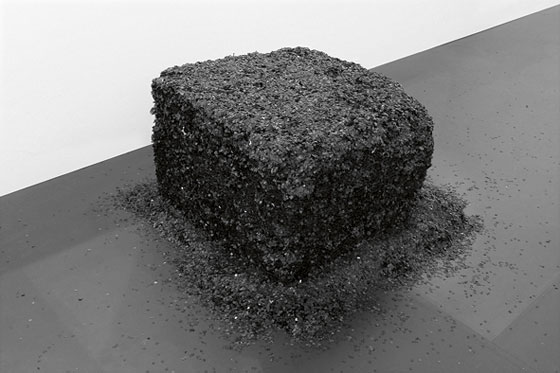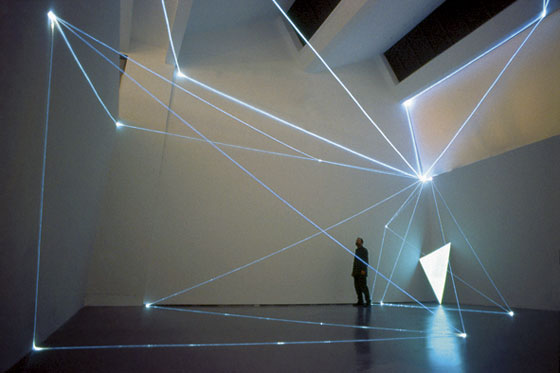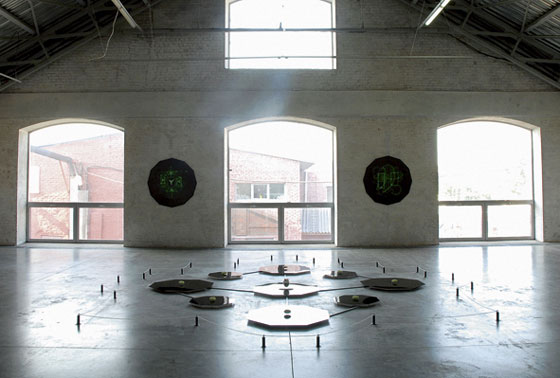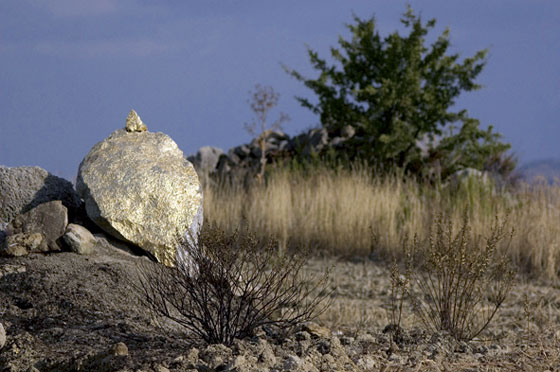|
|
| Vaguely out of fashion or predicting the future? An investigation of the identity card, state of health and limits of contemporary sculpture Barbara Fässler, Artist Conversation with Marco Meneguzzo, curator of the exhibition La scultura Italiana del XXI secolo at the Fondazione Pomodoro in Milan | |
| With a series of two exhibitions at the Fondazione Pomodoro, La scultura Italiana del XX and La scultura Italiana del XXI Secolo [‘Italian Sculpture of the 20th and 21st Centuries’] five years apart, Milanese curator and historian of art Marco Meneguzzo has set himself an ambitious task: to delineate the minimum requirements and the limits of the notion of sculpture of our time. Like a scientist, he defines categories and subsequently verifies whether they correspond in the empirical world to anything real. Hence, among the works on show, analogies are created: formal, material and of content. We find, for example, items which have been taken from everyday life which, however, have been fabricated in precious materials, those normally used in traditional sculpture. Looking at them attentively, we discover in addition to their likeness how some works position themselves in a similar way in space. As is customary in the post-modern era, there is no shortage of forms borrowed from classical or Renaissance works, albeit carried out with modifications in a contemporary key. On the other hand, when observing the two exhibitions one notices the developments which have taken place between the 1990s and the current decade: changes in the materials, the relationship with space, ideas and limits of a category which a long time ago even defined the absolute canon of beauty. From the traditional notions of the beautiful and the ugly it has moved towards a narrative cleverness which is transmitted also through the conscious use of materials, and which seems to have gone beyond classical canons. From traditional materials artists have, in a very short time, passed on to the recycling of prefabricated materials. From the abstract sculpture of the 1990s, in which pure materials had learnt to speak, development has led towards metaphysical reflections on the human condition: from migration to dictatorship. Instead of admiring skilfully sculpted representations in marble, we come up against the principal themes of our age: vanity, the New Economy, animalism, ecology, knowledge, memory and oblivion. During a stroll with Marco Meneguzzo through the second exhibition of the series, Scultura Italiana del XXI Secolo [‘Italian Sculpture of the 21st Century’], passing through an almost infinite variety of forms, colours, references and stories, we have sought to understand where Italian sculpture today has come from and to where it is leading, and above all what could be its direction and its status in an era of weight-lessness par excellence. | |
 Lara Favaretto. One Percent. Confetti. 90x90x90 cm. 2009. Courtesy of Collezione Bernardo and Caroline Attolico | |
| B.F.: Does sculpture still exist, in the era of the immaterial and the virtual? M.M.: Sculpture has this trait: it is cumbersome. As Barnett Newman said: sculpture is the thing that you trip over when you move backwards in order to see a painting better. This is obviously a joke: the witticism of one who has only done painting all his life. But, joking aside, sculpture is indeed made of material, of space and of form. And certainly it is a genre which is vaguely out of fashion, just as heavy things are out of fashion, both in a literal sense as well as metaphorically. B.F.: If it still exists, what then are its characteristic features? M.M.: Whomever were to have the slightest knowledge of sculpture in the history of art up to 1970 would be aware that here there is something completely different, because one imagines sculpture to be in marble or in bronze... B.F.: Immediately at the entrance of the exhibition we bump into a good example of a work that quotes a very well known sculpture which is in bronze...moreover it is not a copy, because the materials and features have been changed. M.M.: It is a fusion of wax cast in aluminium and lacquered pink, the identical colour of skin, it is a hermaphrodite and is titled Donatella (by Giovanni Rizzoli). But quite right, the David of Donatello is also similarly adorned, as cited here, this young man is so feminine and thus our 20th century artist has imparted to it a hint of transgender. Even if you immediately recognise which Renaissance sculpture it is referring to, this new interpretation has something of the absolutely contemporary. B.F.: After the exhibition five years ago, ‘Sculpture of the 20th Century’, the current show is already the second event on this theme in the same exhibition space. It provides an excellent opportunity to take stock: what has changed between the 20th century and the 21st century? M.M.: It is all about weight: at the last exhibition there was a work by Pino Spagnulo which weighed 22 tonnes and was from the 1970s, years that were characterised either by extreme conceptualism or by the idea of brute material being presented as brute material. This artist does something like this: he takes a piece of iron about 30 tonnes in weight, puts it under an enormous hammer which he causes to fall on top of it and the broken pieces that this produces become the sculpture. The action gives shape to the material. Obviously the shape cannot be predicted; you never know how this hammer will fall and where it will break the cube. The intention is that the hammer falls and the material breaks: that is the action. This work represents the most basic concept, the most fundamental, of material and form, which become as they are because of the choice, the wish of the artist. At the previous exhibition you entered and the colour was that of marble or bronze, but in this exhibition of the 21st century, on the contrary, there is a great deal of colour. An art critic such as myself naturally must think that there are indications of what will follow: thus also in the sculpture of the 1990s one can identify something of what the future will bring, and in the first decade of the new century what is likely to follow in the century after. If you were to predict the future, you would perhaps also become rich. Some of the artists from the first exhibition have played “ferrymen” to the second. But even these same artists, if compared amongst themselves, having been shown both in the first exhibition as well as in the second, could appear to be completely different when thrown into another situation. For example, this piece of Nunzio (Attraverso [‘Across’]) has been made out of lightly scorched wood and partly bathed in blue dye... | |
 Carlo Bernardini. Permeable spaces. Optic fibre, electroluminescent surfaces. 9x13x11 m. 2002. Courtesy of Grossetti Arte Contemporanea, Milan; Galleria Delloro, Rome | |
| B.F.: It makes me think of Yves Klein’s blue… M.M.: In truth it is any sort of ultramarine blue, but Yves Klein managed to put his mark on this particular shade of blue, even branding it with his name, just think what courage. And ever since then, when an artist uses this blue, it automatically becomes a reference. Once upon a time it was said that someone uses the yellow of Van Gogh. Certainly, the yellow of Van Gogh exists, but Van Gogh would have never dreamt of putting his brand on that particular shade of yellow. But what I wanted to emphasise is that this artist, who participated in both of our exhibitions, in the previous one was practically a novelty and in this one already seems almost traditional. B.F.: Does sculpture still have any sense or is it to be considered a dying discipline? M.M.: I have touched on this problem, whether artists think that perhaps sculpture no longer has any sense. There’s always been someone who will state that “sculpture is dead”, “art is dead”. Naturally we could have a discussion on the matter, but this discussion would entail that one should define what is sculpture and what is art. We have to identify the dead, if we wish to understand if it is dead. What is the identity card of sculpture? Sculpture is physical, three-dimensional and evolves in space... B.F.: ...also the expressiveness of the materials, I would add. M.M.: It seeks to render physical an idea, certainly. A painting too is something physical that could even injure you, if it were to fall on top of you. B.F.: But today, after ready-made, accumulation, recycling and installation, how does one pin down the materials of sculpture? M.M.: We could ask, in keeping with our definition, whether these forms correspond to the minimum characteristics: is there form, is there space? Yes, in very broad terms. This work on the floor (Paolo Piscitelli, If you fear something, you’ll hear something) is clearly two-dimensional. Why then have I thought of it as being sculpture? Because there exist in any case virtual spaces, as, for example, in photographic works (Untitled by Giuseppe Gabellone) which represent an object that the sculptor has first constructed and then photographed. He will never allow you to see that object itself, but only a photo of it. This object however does exist. Also the video of Alessandro Piangiamore (Untitled), which in an unknown and unidentified place has covered a rock in gold leaf, could be considered as another example of this. This rock becomes your rock, because you have chosen it, and any stone can become a valuable work of art. Its representation by means of a video can be considered as being a sculpture. B.F.: In your text you mention German photographers Bernd and Hilla Becher, who won the ‘Leone d’oro’ for sculpture at the Venice Biennale in 1990. Does this cause you to reflect, given that you consider the photograph, if it hearkens to three-dimensionality and in this particular case architecture, as sculpture in a certain sense, broadly speaking? M.M.: Of course, stretching a point can be dangerous in that if you broaden a notion a bit too far, it vanishes and no longer exists. Where are the limits? This is exactly the problem that contemporary art has: how far can you push an idea? You could say: that’s not important, let’s just make it and that’s all. This too is a possible response. Or else they place everyday items in an artistic context. Like the urinal of Duchamp, signed, given the title Fountain and put on show; clearly it shocks you. But it wouldn’t shock you if you were to take it and put it back into a shop selling sanitary ware. It goes back to being an urinal, soiled, among other things, and you think that the signature of the artist is the initials of the one who has inspected it. If you encounter it in the context of art, however, it takes on another meaning. This is what makes contemporary art fragile, but at the same time extremely interesting, because everything can become a work of art. B.F.: If the artist so chooses... M.M.: Yes, and if he manages to position it in a way that you look at it differently. B.F.: What then are the new materials used by sculptors in the 21st century? M.M.: There’s a bit of everything: there’s crochet (Sissi, Sciolto dalla mano [‘Melted by the Hand’]), a stuffed horse (Maurizio Cattelan, Untitled), there’s more bronze (Gehard Demetz, Hitler Mao; Paolo delle Monache, Archeologia di un istante [‘Archeology of a Moment’]), there’s simulation of a wall as if it were vibrating water (Loris Cecchini, Wallwave Vibrations). Once the material was Matter with a capital M. Bronze was a noble material, you poured it and gave it a shape. It was the original, like marble. These days you no longer speak of matter, but rather of materials. Why should you go into a mine, to excavate material with great effort, given that we are surrounded by 50 thousand objects of the most varied materials and colours which can be of interest and which always correspond to the requirement of occupying space? The work of Fabio Viale, a young Torinese artist, Linea schiacciata [‘Crushed Line’] illustrates in another way this interplay between an everyday object and precious materials. It is most clearly a girder, with the peculiarity that it is a girder made of marble. And if there is anything that is the opposite of a girder, it is precisely a girder of marble. If you look at it closely, you see that he has managed to simulate the elasticity of iron as well. B.F.: What is the game or the thought of the artist? What did he want to tell us? M.M.: The sense of paradox. A girder, usually made of a less valuable material such as iron, here is made of marble, a noble material. B.F.: A bit like the mountain of gold, isn’t it? M.M.: Yes, a little bit, yes. This paradox which he presents us with speaks of both marble and of iron. Through this paradox, he makes us reflect upon matter. Then there are the additional aspects, for example, form. There is also a sense of proportion. If measured according to the parameters of traditional sculpture, these works function perfectly, so perhaps sculpture really does exist. B.F.: And the contents has changed? M.M.: Sculpture today has become very narrative, it tells stories. B.F.: Therefore we have moved away from the abstraction of the 1950s–60s? M.M.: There is a tendency, yes. | |
 Luca Pozzi. 9 churches 9 columns. Electromagnetic fields of levitation, luminescent sponges, aluminium. 2010. Courtesy of Federico Luger; Galleria 42 | |
| B.F.: In what way has narrative returned? M.M.: It’s not enough that the material speaks solely of itself, as in abstraction. For example, Adrian Paci lives in Milan, but he is Albanian. His sculpture Home to go, of someone who takes their home with them, arises from the artist’s history, but ultimately it speaks to us about migration and rootlessness generally. Where is my home? I am carrying it with me. In the work Dispositivo per creare spazio [‘Device for the Creation of Space’] by Gianni Caravaggio, on the other hand, a little plaster has fallen onto a smooth slab of black marble and has created the constellation of a starry sky. It hides a narrative in a form that seems completely abstract. Another example is L’uno per cento [‘One Percent’] by Lara Favaretto: a metre squared cube of confetti. We have constructed a mould, a container and we have filled it with black confetti mixed with coloured confetti. The artist comes and squashes it all like grapes in a vat, and taking away the mould, an almost perfect form emerges. B.F.: Without glue? M.M.: There is no glue whatsoever. You can glimpse a reference to the minimalist art of the 1960s, when a cube was still a cube, but here the cube is fragile, and this give it the feeling of time, of decay. B.F.: Another work that echoes the fragility of the previous: the things that count are the shadows on the wall. M.M.: Grande volante VIII [‘Great Flight VIII’] by Fabrizio Corneli, a Florentine artist, active in the 1980s. One needs to seek relationships between things. For example, in this work of Laura Renna Stormo vulgaris [‘Flock vulgaris’] there are birds and also in another part of the exhibition, in a work by the couple Vedovamazzei (Untitled) there is a thrush with its beak stuck in a wall. As if, during flight, it had crashed into the wall. This work for its part recalls the position of the suspended horse (Untitled) by Maurizio Cattelan. Another couple linked by association is formed by the two gallows: one done in Swarovski crystals (Vanitas Suicide by Nicola Bolla) and the other with an inflatable hanging (Hanging Around by Paolo Canevari). The ‘solid one’ by Massimo Kaufmann Meteoriti di malinconia [‘Meteorites of Melancholy’] made up of bronze brushes is reminiscent of the famous engraving by Dürer, Melencolia, and we meet up again with the same form, as executed by Diamante Faraldo, in A Nord del futuro [‘North of the Future’]. 9 Churches, 9 Columns is a work by the youngest artist in the exhibition, Luca Pozzi. The sponges are suspended, in this way they create fields of force. The outline is reminiscent of the basilica of Saint Basil which is located on the Red Square, and which consists of numerous chapels, one next to the other. Here one sees quite clearly how sculpture is getting lighter. Sculpture of movement spinning around its own axis, Revolutionary Monk by Massimo Bartolini, for its part, plays on the double meaning of the word ‘revolution’, which also can mean to make a complete turn. A prayer, maybe the most static and concentrated thing, here has been conceived as a violent rotation. | |
 Alessandro Piangiamore. Untitled (sacrifice). Gold leaf on rock. 2010. Courtesy of artist and Magazzino, Rome | |
| B.F.: Are there any installations? How would you define the difference between installation and sculpture? M.M.: In an installation it is not the sculpture that occupies the space, but rather the viewers who enter into the sculpture. In the installation of Chiara Dynys, Più luce su tutto [‘More Light on Everything’] we are surrounded by books, all made of glass. Transparent books hold a particular meaning, but the fact that they are also lit up means that they are also illuminating. A book that I like a lot changes me profoundly. In the background video, however, you can see the Archive of the State in Rome, these folders contain all the documents of the state of Italy, from declarations of war to someone who is buying a piece of land that is state property. Clearly it is an important place for remembering, but at the same time it is also a place for forgetting. The artist has in fact written on the flight of steps, on the one side the word memoria [‘remembrance’] and on the other, oblio [‘oblivion’]. Alongside this narrative work we have, in contrast, an abstract intervention. These are the optic fibres of Carlo Bernardini (Spazi permeabili [‘Permeable Spaces’]) which cross the room and take it over. A kind of immateriality, but in reality physical. B.F.: What are your aims as a critic? Could one say that it is historical research? M.M.: Certainly, at the bottom of it all there is this intent, but there is also a wide-ranging, comprehensive exhibition; I wanted to present a range of propositions. We don’t stay together only with artists whom we are used to always seeing together in collective shows, but rather everyone is pitched against everyone else. B.F.: How do you choose your artists? I have noticed that the youngest is from 1983, and the oldest more than 50 years old, there are unheard of names next to artists who are famous throughout the world. M.M.: Here the chief thing is the art. I have been doing this job for more than 35 years, if I don’t know these things... B.F.: Agreed, knowledge and experience are important, but inside this vast field of knowledge you make your precise choice like an artist who chooses the materials for a piece. What then are the criteria for your choice? M.M.: At first I have a feeling, an emotion, then I seek to evaluate it and ask myself: what is the sculpture now? I try to create categories and subsequently assess whether these categories exist in reality. I am interested in the problem of space and that of materials. How everything has changed. To tell the truth, not all of these 80 sculptures are to my liking. Many are here because they represent something. The theory and the practice go together. You have a theory and you try to verify it, exactly like a scientist. A critic and an artist are not like scientists, however, because they don’t have to prove anything. All the same by creating categories, one nevertheless expresses a judgment. A critic is not simple a sort of translator into words of what one sees. It would be a disaster for the critic, but above all for the artist, if everything were to be transferable to another language. /Translated from the Italian by Terēze Svilane/ | |
| go back | |







